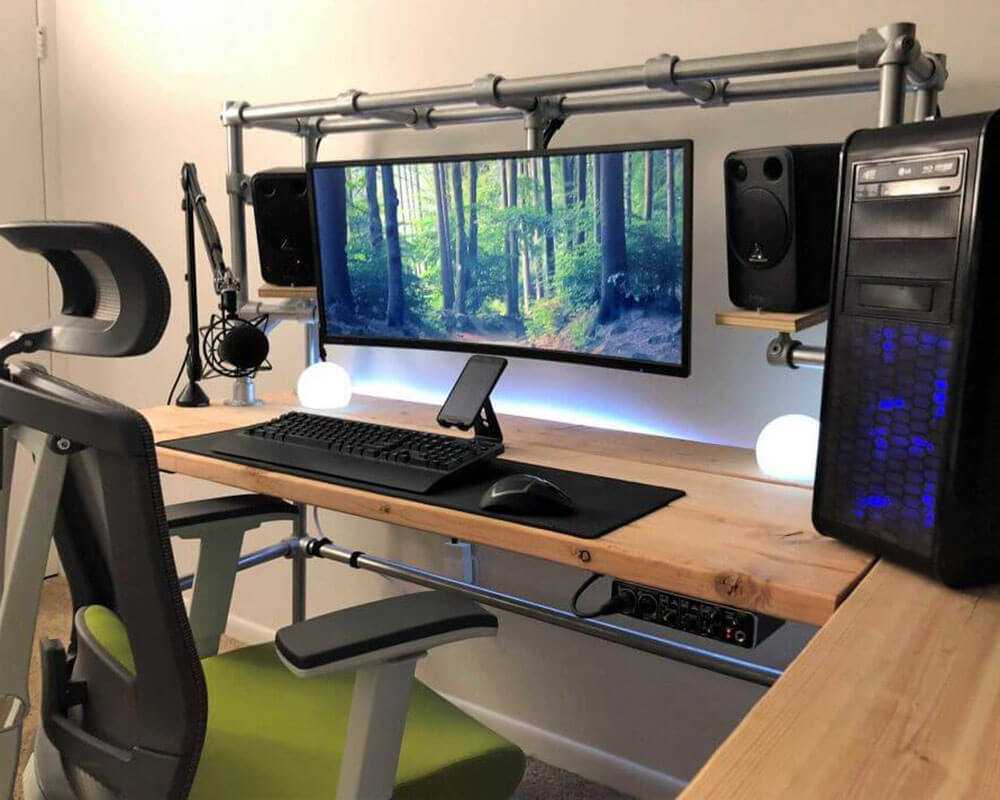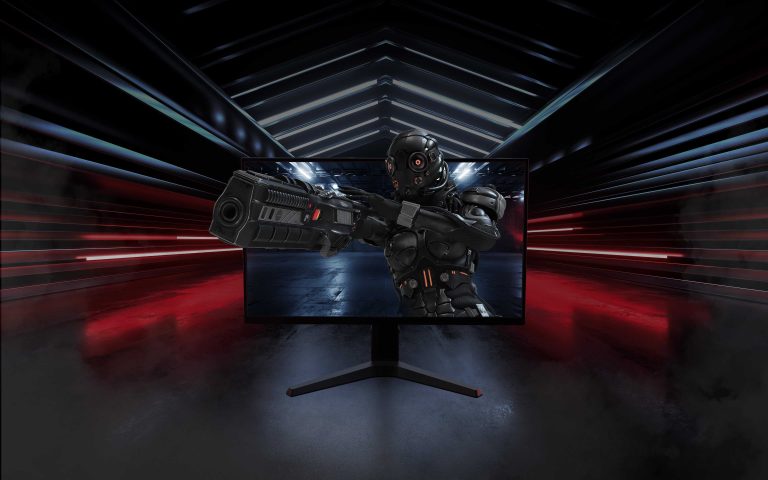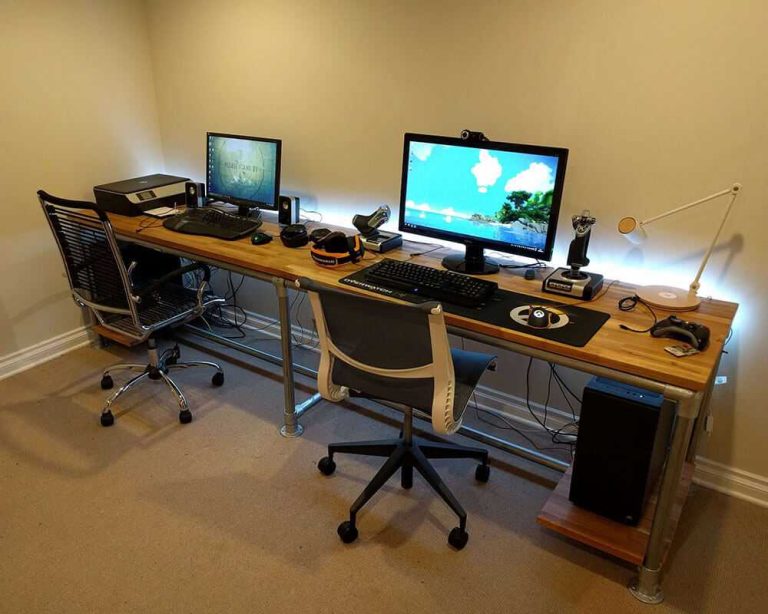Building a custom gaming desk can be an exciting project that enhances your gaming experience. Start by measuring your available space and determining what features you want, such as cable management, storage, and a comfortable height. Use sturdy materials like plywood or MDF for the surface and consider adding a solid frame for support. Customize the desk to fit your gaming setup, whether that’s multiple monitors or extra space for your gear. Don’t forget to personalize it with colors or designs that reflect your gaming style. With the right tools and a little creativity, you can create a gaming desk that’s not only functional but also uniquely yours. Let’s dive into the steps to turn your vision into reality!
How to Build a Custom Gaming Desk
Building a custom gaming desk can be an exciting project. It allows you to personalize your gaming setup to suit your needs perfectly. In this guide, we will cover all the important steps to create a gaming desk that is both functional and stylish. Let’s dive in!
Why Build a Custom Gaming Desk?
Creating your own gaming desk has many advantages. A custom desk can maximize your available space and accommodate all your gaming gear.
– **Personalization**: You can choose colors, materials, and design that reflect your style.
– **Functionality**: Tailor the size and layout to suit your gaming setup.
– **Cost-Effective**: Building your own desk can save you money compared to buying a pre-made one.
Planning Your Custom Gaming Desk
Before you start building, it’s essential to plan your design. This involves taking measurements and deciding on the overall look of the desk.
Determine Your Needs
Consider what you need from your gaming desk. Some questions to ask include:
– How much space do you have available?
– What equipment will you use? (Monitor, keyboard, mouse, etc.)
– Do you need additional storage?
Sketch Your Design
Put your ideas on paper. A simple sketch helps visualize your desk.
– Include dimensions and layout.
– Make notes on special features, like cable management or shelves.
Gathering Materials and Tools
Once you have a plan, it’s time to gather your materials. Here’s a list to get you started:
- Wood (plywood or MDF for the desktop)
- Wood screws
- Sandpaper
- Wood stain or paint
- Wood glue
- Legs or a frame
- Drawer slides (if needed)
- Tools (saw, drill, screwdriver, measuring tape)
Building Your Gaming Desk
Now that you have your materials, let’s start building!
Step 1: Cutting the Wood
Measure and cut the wood according to your design. Make sure to wear safety goggles while using power tools.
– For a standard desk, a top size of 60 inches by 30 inches is a good starting point.
– Cut the wood for the legs or frame to the desired height, usually around 28 to 30 inches.
Step 2: Sanding the Edges
After cutting, sand the edges of the wood. This gives it a smooth finish and prevents splinters.
– Use medium-grit sandpaper first, then finish with fine-grit sandpaper.
– Ensure all surfaces are even and smooth.
Step 3: Assembling the Desk
Start assembling the frame of the desk.
– Use wood glue for added strength.
– Secure the legs to the bottom of the desktop using wood screws.
Step 4: Adding Finishing Touches
Once assembled, it’s time to paint or stain your desk.
– Choose a finish that matches your gaming setup.
– Apply multiple coats for a deeper color and better durability.
Incorporating Functional Features
To enhance your desk, consider adding some functional features.
Cable Management
Keeping cables organized makes your desk look neat. Here are some options:
– Use cable clips or sleeves.
– Add a cable tray under the desk to hide wires.
Storage Solutions
Think about where you will store gaming accessories.
– Use drawers for controllers and headsets.
– Consider adding shelves for games or books.
Making Your Desk Comfortable
A gaming desk should be comfortable for long hours of use.
Ergonomics
Ensure the height of your desk suits your chair. Your elbows should be at a 90-degree angle when using the keyboard.
– If your desk is too high, consider a different chair or a footrest.
– If it’s too low, you may need to adjust the legs or use risers.
Adding a Mouse Pad
A large mouse pad can improve the gaming experience. It gives a smooth surface for the mouse and protects the desk surface.
– Choose a pad that fits your style and gaming needs.
Finishing Touches and Decoration
After completing the structure, add decorations that reflect your personality.
- Gaming posters on the wall
- LED lights under the desk
- Custom gaming accessories
Personalized Elements
Consider adding personal touches to your desk.
– Items like figurines or framed pictures can bring your desk to life.
– Choose colors that fit with your overall gaming theme.
Maintaining Your Gaming Desk
Once your desk is built and decorated, regular maintenance ensures it stays in good shape.
Cleaning
Keep your desk clean and organized.
– Wipe down surfaces with a soft cloth.
– Remove dust from cables and stored items regularly.
Checking for Wear and Tear
Inspect your desk periodically for any signs of damage. Ensure screws are tight and the surface is intact.
– Fix any issues immediately to prevent further damage.
Building your custom gaming desk is a rewarding project. You can create a space that meets all your gaming needs while reflecting your personal style. Enjoy the process and the end result!
DIY gaming desk #woodworking #diy #wood #carpenter #explore #reel
Frequently Asked Questions
What materials are best for a custom gaming desk?
When building a custom gaming desk, choosing the right materials is crucial for durability and aesthetics. Popular options include plywood, MDF, and solid wood for the desk surface due to their sturdiness. For the frame, metal supports or wood can provide strong structural integrity. Consider using a laminate or veneer finish to enhance the appearance while protecting the surface. Don’t forget about cable management solutions using PVC conduits or cable trays to keep everything organized and tidy.
How can I ensure my gaming desk is ergonomic?
To create an ergonomic gaming desk, focus on the height and layout. Adjust the desk height so that your elbows are at a 90-degree angle when using your keyboard and mouse. Consider the depth of the desk to allow for a comfortable viewing distance from the monitor. An adjustable chair complements your desk setup by supporting your lower back. Additionally, place monitor screens at eye level to prevent neck strain while gaming.
What features should I include in my gaming desk design?
Including features that enhance functionality is essential in your custom gaming desk design. Consider integrating built-in storage solutions like drawers or shelves for games and accessories to keep your space organized. Cable management systems help you avoid clutter and maintain a clean look. Additionally, you might want to add LED lighting strips for ambiance and to personalize your setup. A mousepad that covers the entire desk surface can also improve gameplay comfort.
How can I personalize my gaming desk?
Personalizing your gaming desk adds a unique touch to your gaming space. You can use custom paint or decals to create a look that reflects your style. Incorporating themed accessories, such as figurines or posters, also helps to enhance the atmosphere. Consider using RGB lighting to create an immersive environment. Additionally, integrating your favorite colors into the design can make the desk feel more personal and inviting.
What tools do I need to build a custom gaming desk?
Building a custom gaming desk requires several essential tools for a successful project. Start with a measuring tape and a square to ensure accurate dimensions. You’ll need a saw (either a circular saw or jigsaw) for cutting your materials, a drill for making holes for screws, and screws and fasteners to assemble the desk. Sandpaper is important for smoothing edges, and paintbrushes or rollers will help if you decide to paint or stain your desk. A level will ensure that your desk sits evenly.
Final Thoughts
Building a custom gaming desk requires careful planning and the right materials. Start by measuring your space to ensure a perfect fit and select a sturdy surface that accommodates your gaming gear.
Consider adding features like cable management, storage solutions, and adjustable components to enhance functionality.
Finally, put your personal touch on the design to make it uniquely yours. Following these steps will guide you on how to build a custom gaming desk tailored to your gaming needs.
I’m passionate about hardware, especially laptops, monitors, and home office gear. I share reviews and practical advice to help readers choose the right devices and get the best performance.






